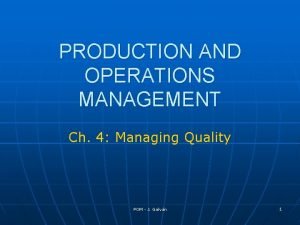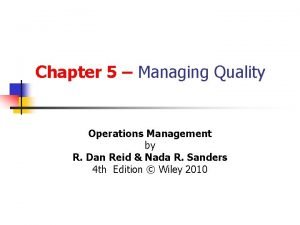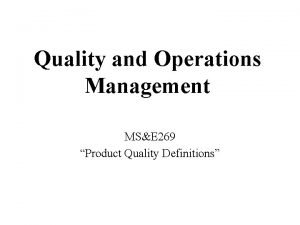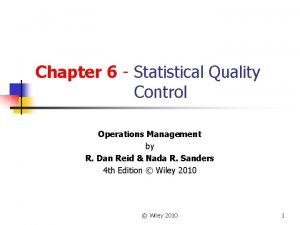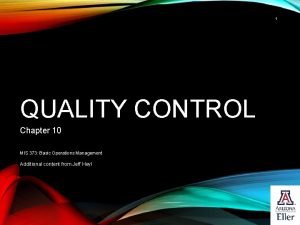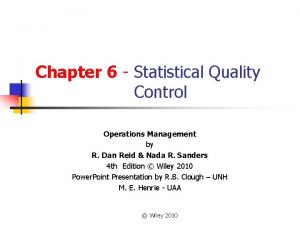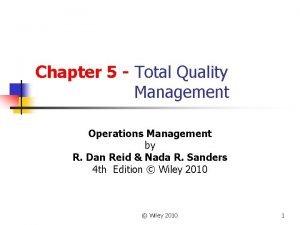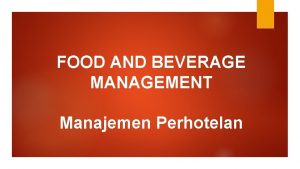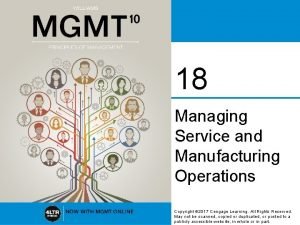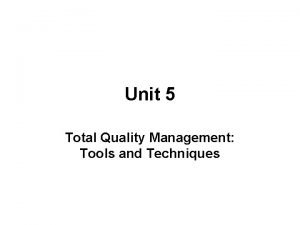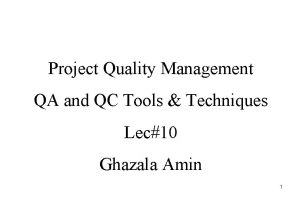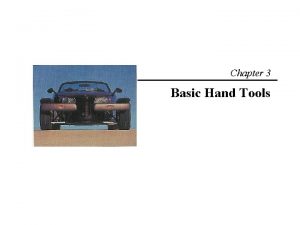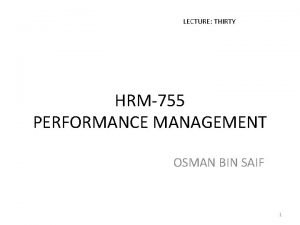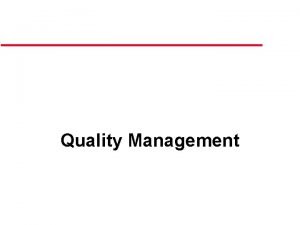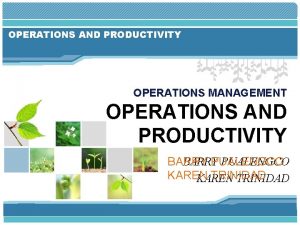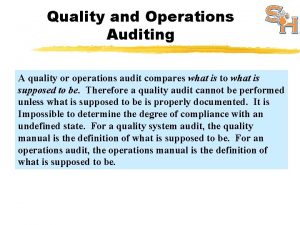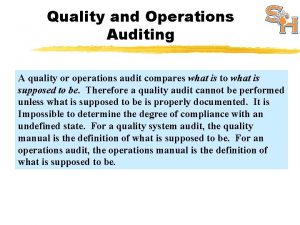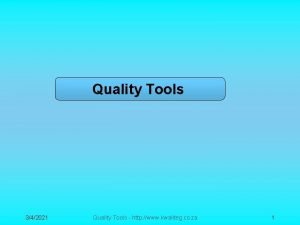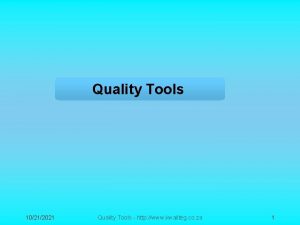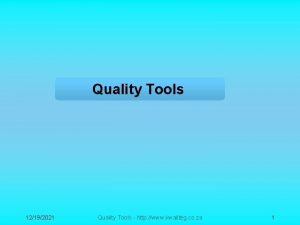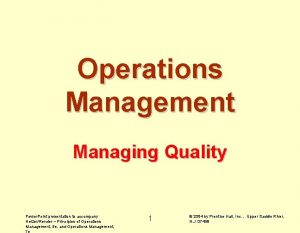Operations Management Lecture 6 Managing Quality Quality tools































- Slides: 31

Operations Management Lecture 6 – Managing Quality (Quality tools implications and Problem solving) Power. Point presentation to accompany Heizer/Render Principles of Operations Management, 7 e Operations Management, 9 e © 2008 Prentice Hall, Inc. 6– 1

Recap þ TQM & Deming 14 points þ Total Quality Management þ Continuous Improvement þ Six Sigma þ Employee Empowerment þ Benchmarking þ Just-in-Time (JIT) þ Taguchi Concepts © 2008 Prentice Hall, Inc. þ Knowledge of TQM Tools 6– 2

Recap – Continued þ Tools of TQM þ Check Sheets þ Scatter Diagrams þ Cause-and-Effect Diagrams þ Pareto Charts þ Flowcharts þ Histograms þ Statistical Process Control (SPC) © 2008 Prentice Hall, Inc. 6– 3

Course Outline þ Implications of Quality tools and Problem solving þ Check Sheets þ Scatter Diagrams þ Cause-and-Effect Diagrams þ Pareto Charts þ Flowcharts þ Histograms © 2008 Prentice Hall, Inc. þ Statistical Process Control (SPC) 6– 4

The histogram below shows the heights (in cm) distribution of 30 people. a) How many people have heights between 159. 5 and 169. 5 cm? b) How many people have heights less than 159. 5 cm? c) How many people have heights more than 169. 5 cm? d) What percentage of people have heights between 149. 5 and 179. 5 cm? a) 7 people b) 9 + 6 = 15 people c) 5 + 2 + 1 = 8 people d) (9 + 7 + 5)/30 = 0. 7 = 70%. . . © 2008 Prentice Hall, Inc. 6– 5

The histogram below shows the efficiency level (in miles per gallons) of 110 cars. a) How many cars have an efficiency between 15 and 20 miles per gallon? b) How many cars have an efficiency more than 20 miles per gallon? c) What percentage of cars have an efficiency less than 20 miles per gallon? a) 35 cars b) 25 + 15 = 40 cars c) (15 + 20 + 35) / 110 = 0. 636 = 63. 6%. . © 2008 Prentice Hall, Inc. 6– 6

Example (Pareto chart) The Hard Rock Hotel has just collected the data from 75 complaint calls to the general manager during the month of October. The manager wants to prepare an analysis of the complaints. The data provided are room service, 54; check-in delays, 12; hours the pool is open, 4; minibar prices, 3 and miscellaneous, 2. © 2008 Prentice Hall, Inc. 6– 7

© 2008 Prentice Hall, Inc. 6– 8

Pareto Charts Data for October Frequency (number) 70 – 60 – 54 – 72 50 – 40 – Number of occurrences 30 – 20 – 12 10 – 4 0 – Room svc 72% Check-in Pool hours 16% 5% 3 2 Minibar 4% Misc. 3% Cumulative percent – 100 – 93 – 88 Causes and percent of the total © 2008 Prentice Hall, Inc. 6– 9

Flow Charts MRI Flowchart 1. 2. 3. 4. 5. 6. Physician schedules MRI Patient taken to MRI Patient signs in Patient is prepped Technician carries out MRI Technician inspects film 1 2 3 4 5 7. 8. 9. 10. If unsatisfactory, repeat Patient taken back to room MRI read by radiologist MRI report transferred to physician 11. Patient and physician discuss 6 7 80% 8 11 9 10 20% © 2008 Prentice Hall, Inc. 6 – 10

Cause-and-Effect Diagrams Method (shooting process) Material (ball) Grain/Feel (grip) Size of ball Aiming point Bend knees Air pressure Hand position Lopsidedness Follow-through Training Conditioning Consistency © 2008 Prentice Hall, Inc. Missed free-throws Rim size Motivation Rim alignment Concentration Manpower (shooter) Balance Rim height Backboard stability Machine (hoop & backboard) 6 – 11

Statistical Process Control (SPC) þ Uses statistics and control charts to tell when to take corrective action þ Drives process improvement þ Four key steps þ Measure the process þ When a change is indicated, find the assignable cause þ Eliminate or incorporate the cause þ Restart the revised process © 2008 Prentice Hall, Inc. 6 – 12

An SPC Chart Plots the percent of free throws missed 20% Upper control limit 10% Coach’s target value 0% | | | | | 1 2 3 4 5 6 7 8 9 Lower control limit Game number © 2008 Prentice Hall, Inc. 6 – 13

Example: The local ice cream shop keeps track of how much ice cream they sell versus the temperature on that day. Here are their figures for the last 12 days: Ice Cream Sales vs Temperature © 2008 Prentice Hall, Inc. Temperature °C Ice Cream Sales 14. 2° $215 16. 4° $325 11. 9° $185 15. 2° $332 18. 5° $406 22. 1° $522 19. 4° $412 25. 1° $614 23. 4° $544 18. 1° $421 22. 6° $445 17. 2° $408 6 – 14

It is now easy to see that warmer weather leads to more sales. © 2008 Prentice Hall, Inc. 6 – 15

Problem • Management is concerned that workers create more product defects at the very beginning and end of a work shift than at other times of their eight hour workday. Construct a scatter diagram with the following data, collected last week. Is management justified in its belief? © 2008 Prentice Hall, Inc. 6 – 16

Solution There is fairly convincing evidence that there are more defects in the first and last shift hours than at other times. © 2008 Prentice Hall, Inc. 6 – 17

Problem The accounts receivable department has documented the following defects over a 30 -day period: What techniques would you use and what conclusions can you draw about defects in the accounts receivable department? Category Frequency Invoice amount does not agree with the check amount 108 Invoice not on record (not found) 24 No formal invoice issued 18 Check (payment) not received on time 30 Check not signed 8 Invoice number and invoice referenced do not agree 12 © 2008 Prentice Hall, Inc. 6 – 18

Solution Category Frequency Percent Cumulative % 108 54 54 30 15 69 Invoice not on record (not found) 24 12 81 No formal invoice issued 18 9 90 12 6 96 8 4 100 200 100 Invoice amount does not agree with the check amount Check (payment) not received on time Invoice number and referenced do not agree invoice Check not signed S= © 2008 Prentice Hall, Inc. 6 – 19

© 2008 Prentice Hall, Inc. 6 – 20

Problem © 2008 Prentice Hall, Inc. 6 – 21

Solution . . . © 2008 Prentice Hall, Inc. . 6 – 22

Problem © 2008 Prentice Hall, Inc. 6 – 23

Solution . . . © 2008 Prentice Hall, Inc. 6 – 24

Problem Construct a cause-and-effect diagram showing why a student might be dissatisfied with the cafeteria. © 2008 Prentice Hall, Inc. 6 – 25

Solution © 2008 Prentice Hall, Inc. 6 – 26

Problem Draw a fishbone chart detailing reasons why a part might not be correctly machined. © 2008 Prentice Hall, Inc. 6 – 27

© 2008 Prentice Hall, Inc. 6 – 28

Problem Prepare a flow chart for purchasing a Big Mac at the drive-through window at Mc. Donalds. © 2008 Prentice Hall, Inc. 6 – 29

© 2008 Prentice Hall, Inc. 6 – 30

Forthcoming lecture: Linear Programming © 2008 Prentice Hall, Inc. 6 – 31
 Managing quality in operations management
Managing quality in operations management Managing quality in operations management
Managing quality in operations management Managing quality in operations management
Managing quality in operations management Operations and quality management
Operations and quality management What is tqm
What is tqm Om 306
Om 306 Project quality management lecture notes
Project quality management lecture notes 01:640:244 lecture notes - lecture 15: plat, idah, farad
01:640:244 lecture notes - lecture 15: plat, idah, farad Quality and operations management
Quality and operations management Statistical quality control in operations management
Statistical quality control in operations management Operations management chapter 10 quality control solutions
Operations management chapter 10 quality control solutions Statistical quality control in operations management
Statistical quality control in operations management House of quality operations management
House of quality operations management Quality operations management
Quality operations management Food and beverage preparation service management
Food and beverage preparation service management Managing service and manufacturing operations
Managing service and manufacturing operations Managing service and manufacturing operations
Managing service and manufacturing operations Managing front office operations 10th edition
Managing front office operations 10th edition Total quality management tools and techniques
Total quality management tools and techniques Project management quality tools
Project management quality tools Quality control tools and techniques in project management
Quality control tools and techniques in project management Operations management chapter 12 inventory management
Operations management chapter 12 inventory management Basic hand tools
Basic hand tools Sewing tools measuring tools
Sewing tools measuring tools Foqa faa
Foqa faa Contemporary
Contemporary Project procurement management lecture notes
Project procurement management lecture notes Strategic management lecture
Strategic management lecture Wwwwwhh
Wwwwwhh Financial management lecture
Financial management lecture Objective of public sector accounting
Objective of public sector accounting Performance management lecture
Performance management lecture
